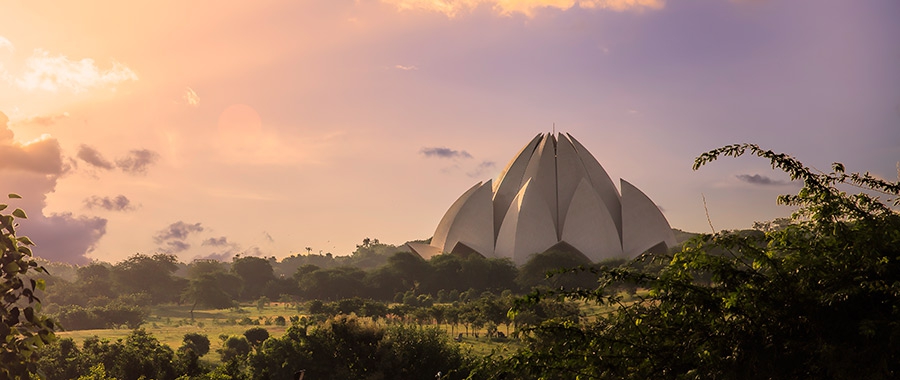The views expressed in our content reflect individual perspectives and do not represent the authoritative views of the Baha'i Faith.
If you are fortunate enough to visit the magnificent country of India—rich in spiritual heritage, mythology and history—you will no doubt be directed to tour the stunning Baha’i Lotus Temple. A prominent attraction in Delhi, this architectural wonder is visited even more than the Taj Mahal. With an average of 10,000 visitors per day, attendance has reached as high as 150,000 in one day.
Most notable for its flowerlike shape, the Lotus Temple is open to all religions and every aspect of humanity—as are all Baha’i Houses of Worship. The building is comprised of 27 large “petals” arranged in three levels, each with nine petals, forming nine sides with nine doors opening into a central hall. The Lotus Temple has received numerous architectural awards and is frequently featured in magazine and newspaper articles. It is reported to be one of the most visited buildings in the world.
Fariborz Sahba, the Iranian-American Baha’i architect who designed this Temple, said its lotus shape was specifically selected because of its numerous spiritual meanings. He explained: “The lotus represents the Manifestation of God [divine messengers and prophets], and is also a symbol of purity and tenderness. Its significance is deeply rooted in the minds and hearts of the Indians.” – Fariborz Sahba, quoted in “In the shadow of the lotus, peace and calm prevail,” Baha’i World News Service, 19 March 2008.
The symbol of the lotus, common to many Indian religions, represents religious harmony and unity in India. This Baha’i House of Worship uniquely expresses the lotus symbol through its prominent use of light and water rather than ornate carvings and statues. Its divine simplicity and purity reflect the spiritual values of the Indian people, and the tenets of the Baha’i Faith:
O son of spirit! My first counsel is this: Possess a pure, kindly and radiant heart, that thine may be a sovereignty ancient, imperishable and everlasting. – Baha’u’llah, The Hidden Words, p. 3.
The lotus symbol can be traced back to many different religions. It features prominently in Zoroastrian architecture, is seen frequently in the patterns of Persian carpets, and can often be viewed in Islamic architecture from the Seljuq dynasty.

The spiritual symbolism of the flower is found in Egyptology, Hinduism and Buddhism. The design of a lotus flower held in hand symbolizes divine birth and everlasting life. Many images of the Buddha contain a lotus flower ornamenting his hands. The concept of the divine lotus comes from the myth that Buddha had the wondrous power of imprinting the image of a lotus flower on the earth with each step he took.
The purpose of the Baha’i Lotus Temple is to serve as a constant reminder, to anyone and everyone, that the religions of the world have much in common, and promote many of the same spiritual teachings—and that the Baha’i Faith looks upon the Indian people—and indeed all people—with respect and love:
This is a new cycle of human power. … It is the hour of unity of the sons of men and of the drawing together of all races and all classes. You are loosed from ancient superstitions which have kept men ignorant, destroying the foundation of true humanity. The gift of God to this enlightened age is the knowledge of the oneness of mankind and of the fundamental oneness of religion. – Abdu’l-Baha, Abdu’l-Baha in London, p. 19.
The lotus appears on many architectural monuments of Hinduism throughout India, and extends all the way to Japan.
It is also prominent in Indian literature. Mentioned in the oldest Veda (ancient Hindu scriptures written in Sanskrit), the lotus flower features prominently in the mythology of Brahmanism (the religious and social system of the Brahmans and orthodox Hindus). Considered in India as the fairest flower, Sanskrit poems constantly compared the beauty of the lotus to the faces of heroines. It is also mentioned in the Rigveda, Samhitas, and the Atharvaveda (collections of writings, hymns and mantras), sometimes being compared to the human heart.
In Indian myths, many marvelous stories describe its beauty and the fact that the lotus grows out of the water and mud. The profound symbolism of this—that the flower grows from mud, and only from mud—is my favorite thing about the lotus. It must grow through the mud in order to blossom. Like the lotus, we must also learn to grow and bloom through the tests and difficulties we face in life:
As a lotus flower is born in water, grows in water and rises out of water to stand above it unsoiled, so I, born in the world, raised in the world having overcome the world, live unsoiled by the world. – The Buddha, quoted by Anuradha Seneviratna in The Buddha Sakyamuni, p. 5.
It’s like growing lotus flowers. You cannot grow lotus flowers on marble. You have to grow them on the mud. Without mud you cannot have lotus flowers. Without suffering, you have no way to learn how to be understanding and compassionate. – Thich Nhat Hanh, quoted in “Thich Nhat Hahn, Cheri Maples and Larry Ward: Being Peace in a World of Trauma,” On Being, 14 July 2016.
Men who suffer not, attain no perfection. The plant most pruned by the gardeners is that one which, when the summer comes, will have the most beautiful blossoms and the most abundant fruit. – Abdu’l-Baha, Paris Talks, p. 50-51.
The beautiful Baha’i Lotus Temple welcomes the world as a beacon of peace, universal love and unity. Multi-faith services include prayers, chanting and readings from diverse religions, to recognize the essential unity and spiritual oneness of all faiths. With a myriad of symbolic meanings woven into its petal-like structure, the Lotus Temple is a glorious place to lose one’s ego, rekindle one’s spirit and connect with all of humanity.
If you feel lost, disappointed, hesitant, or weak, return to yourself, to who you are, here and now and when you get there, you will discover yourself, like a lotus flower in full bloom, even in a muddy pond, beautiful and strong. – Masaru Emoto, The Secret Life of Water.
All mankind are the fruits of one tree, flowers of the same garden, waves of one sea. – Abdu’l-Baha, The Promulgation of Universal Peace, p. 118.
















Comments
Sign in or create an account
Continue with Googleor